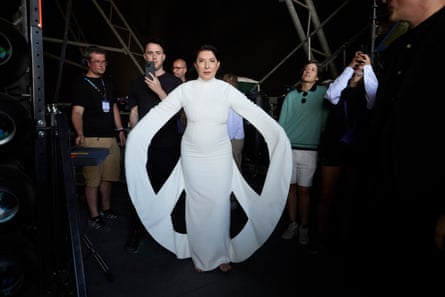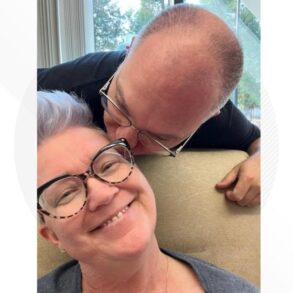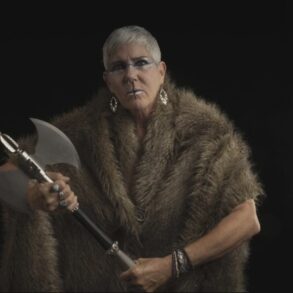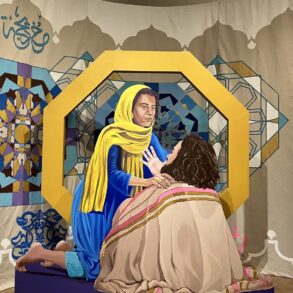The godmother of performance art begins by telling me off: “You are early! Why are you early?” Well, you know, I just wanted to check Zoom was working – camera, microphone and everything. Also, she’s already here – she’s even earlier. “I come from communism. You have to be on time,” she says, referring to the first 30 years of her life in Tito’s Yugoslavia. “In Japan, if you’re on time, you’re late. And in Paris, if you’re early, they’re incredibly embarrassed, you know … the horse is taking shower …”
What? The horse is taking a shower?
“HOST. The host is taking a shower, nobody’s ready, you have to be absolutely at least 15 minutes late.”
Got it. Different national, cultural and political attitudes to timekeeping and punctuality. We’ll come back to communism.
Marina Abramović is at her country place in upstate New York, sitting by the window with the morning sunshine flooding in, cup of tea in hand. “Always Yorkshire Gold. I have packages of Yorkshire Gold everywhere I go. I think that definitely they have to give me some. I’m so much advertising Yorkshire Gold because it’s so tasty and flavourful.” She laughs.
It doesn’t feel right speaking on a video call when over the years, in so much of Abramović’s work, she has been present and visceral and in the audience’s face. Literally in the case of The Artist Is Present, her breakthrough 2010 show, in which she sat on a chair in the Museum of Modern Art in New York (MoMA) every day for three months while thousands queued to sit opposite her.
Now, though, the artist is present only on my screen. But hey, as we’re both early, perhaps we could recreate the MoMA piece and sit in silence for a minute? I promise not to strip (as one person did). I can’t promise not to weep, as many did, overwhelmed by the intensity of the experience … “This is such a terrible idea. I hate it. Why should I do something I’ve done already? I know it’s a very iconic work but I don’t have a reason. Always I have to have a reason.”
Rebuked again, and we’ve only just begun. It sets the tone for our “interview”. Abramović holds court; it still feels like a performance of sorts. It comes pouring out, with scant regard for articles (definite and indefinite), but brilliant, hilarious, sometimes preposterous, and almost entirely about Abramović, about whom she is rather pleased. Occasionally I have the audacity to interrupt to ask a question (once I find myself putting my hand up), which she might engage with, or she might dismiss as stupid.

She doesn’t like to dwell on the past, she says, but does talk a bit about The Artist Is Present – how she changed her entire metabolism, “like astronauts”, so she could sit there all day without eating or drinking or going to the toilet. “It was a huge commitment.”
She had been performing for years, pushing her limits, exploring the power and vulnerability of her body, through mutilation, stabbing, fire. With the German artist Ulay, her collaborator and lover, they performed head-on collisions, running naked into each other again and again, and tied themselves together with their hair. But it was The Artist Is Present that catapulted Abramović to godmother status, and found a whole new audience not just for her but for performance art. A shoutout from Lady Gaga helped – the stars came out to sit with Abramović: Lou Reed, Björk, Alan Rickman. Ulay too, although they had long since separated, then fallen out, squabbling bitterly over their joint archive. But in MoMA he sat down, she opened her eyes, smiled, wept, reached out, they held hands, he departed. Clips of it have been viewed many millions of times; it’s impossible not to be moved.
When Ulay died in 2020, they were, she says, at peace. “Our relation was a big love story. It was difficult, it was hell; when it was good, it was good, when it was bad, it was bad. He sued me, he won … I hated him. Then we met each other again. I forgave him.”
Abramović has a new exhibition opening in Shanghai this week, and Ulay’s DNA lives on in some of the work. In 1988 their separation itself became a work of epic performance when they set off walking from opposite ends of the Great Wall of China. After three months, they met in the middle, hugged, then that was it; they were no longer together. The new exhibition, titled Transforming Energy, features more than 1,000 images from the walk.
As well as a dramatic way of splitting up (this was pre-SMS), Abramović’s Great Wall walk was in part inspired by her father, who took part in the Igman March in 1942, a march by the First Proletarian Brigade over the mountains from Sarajevo, in freezing conditions, to evade the Nazis. Both her parents were good communists, and attained positions in the postwar Yugoslavian government.
Marina horrified her parents, lying down within a burning communist star, cutting a star into her stomach. Aged 30, she left to go and live in Amsterdam. “But my problem was really my issue with my family – absence of love, and I never was good enough. But I learned iron discipline; this is why I’m always on time maybe, hahaha. The willpower – if I have something to do, I will do whatever it takes. Because, you know, the entire [idea of] communism was, you have to give to the community as best you can, and this is very important.”
She has been a fierce critic of Vladimir Putin and other politicians, but she is careful not to say anything about China. “I’ve tried to show my work in China for 20 years – for 20 years different museums have asked me to come. I send a proposal, they accept it, the proposals have to go to government, and each time the government said no, because of nudity or whatever; there’s so many restrictions.”




So what will visitors to Abramović’s first exhibition in China experience, apart from images of the walk? “Transitory objects. Not sculptures – they’re actually objects.” The performance will come from the public interacting with the material she’s using, material she encountered on the Great Wall of China. “It’s all directly related to my Abramović Method that I developed – that by doing repetitive, repetitive work, you can change your consciousness.”
I ask her to describe one of these objects so I can picture it. One piece consists of five doors, each of which has a facilitator by it. “I sent my people from my institute to train them. So they’re standing in front of an iron door, a simple door, and they are slowly opening it and not entering, slowly closing it and not exiting – it’s only the action of opening and entering, but it’s three hours of that action. That’s what is so important … In the beginning you think, OK it’s amusing, and then you’re crazy, and then you’re bored, and then you want to kill me; all of this can happen. But then if you continue, the door is not a door any more. The door is opening consciousness, the door is about life, the door can be so many things, because your mind kind of gets shifted to something else.” She also tells me about a metronome that ticks only every 24 seconds and might just send you into a parallel reality.
I heard there were going to be crystals. “An enormous amount of crystals,” she admits. Boxes and boxes of them shipped from Brazil. She didn’t mention them because everyone immediately associates them with “new wave, magic bullshit, all of this – it’s not about that”. She talks about how scientists have stored a huge amount of data on crystals. “So crystals condense light, electricity and memory. They’re really very powerful, and if you could connect with that you really feel it, but it’s not something that you can do in five minutes. You have to have time. You know, you don’t get muscles in the gym in one day. So you have to really stay with it, with that energy in the space for a while.”
But when you talk about crystals and energy, doesn’t it sound a bit, you know, new wave, magic bullshit? “But how I can do differently? We don’t have words or language that I can invent a new way. So this is why I try not even mention crystals; just that the show is called Transforming Energy.”




I want to ask if there’ll be reiki healing but bottle it, I’m afraid. Which – on a different, but possibly connected, subject – is literally exactly what Abramović has done – with cranberry juice, grapeseed flour, calamus root, liquorice, fresh garlic and some other ingredients, to produce energy drops, immune drops and anti-allergy drops, all available at the Marina Abramović Longevity Method website at £99 for 100ml. I do ask her about this unlikely side hustle.
She says a doctor and holistic practitioner called Nonna Brenner, from Kazakhstan, treated her when she had Lyme disease, using old methods to help her energy, etc. “This is nothing to do with wrinkles; this is to do with wellbeing. And then I actually lent my name, because nobody knows about her, to sell these products. To get better, what you need to have is a strong immune system. You have to have no allergies and you have to have energy in order to live a long life. So this is just wrong criticism.”
You just might not expect this kind of longevity product endorsement from the most influential feminist performance artist of the age, though. “First, I’m not feminist. I think art doesn’t have gender, and I don’t like to be in any kind of group.”
OK, but it still seems quite a leap, from pushing the limits of endurance and pain in order to explore the power and vulnerability of her body, to pushing, well, wellness products for £100. Perhaps it’s not surprising there have been accusations of, whisper it, selling out? “Yeah, but it’s not my price, and I’m not getting that money anyway; I get from this 10% just to use my name. And I haven’t ever seen this money yet, because they have to invest in advertising.”
Though I’m dubious of the science, the longevity stuff seems to be working: she looks great. She says she’s full of energy and working harder than ever at 77. She may be due a new knee in November, but there are no plans to slow down or stop working. “This is something that gives me purpose. There’s plenty of time to stay in the grave and not do anything. It’s horrifying the idea of [having a] pension, you know: sit in the front of television and wait to die. That’s not me.”
She’d like to make it 100. “Because, you know, Louise Bourgeois didn’t make 100, Georgia O’Keeffe didn’t make 100. You really get respect after you make 100 – everybody looking at you with new eyes.”




She played Glastonbury this year; she’s an actual rock star. Dressed by her friend, the designer Riccardo Tisci, as a CND peace symbol, she took to the Pyramid stage and demanded – and mostly got – seven minutes of silence, harnessing positive energy to act against war and violence. “I’m very proud of Glastonbury. Everybody says to me, this is suicidal, are you out of your fucking mind, the people are on mushrooms, on drugs, how can you make 275,000 people silent for seven minutes? I had to take risks, I really did. It was magical, incredible.”
It wasn’t just the people there. “You know how many TV viewers we had for that? One-point-one billion. I can send you the data – that’s even more than Trump,” she says, sounding just a tiny bit like Trump, perhaps …
Anyway, the point is, Marina Abramović is really, really famous. “In some countries I can’t walk without a bodyguard. In Italy, the women will run on to the street and give me a baby just to hold.” Bigger than the pope, too, perhaps? “Honestly I’m loved, it’s true, it feels really great.”
I wonder if she ever thinks nostalgically back to the early days, living in a van with Ulay and her Albanian shepherd dog. “I do,” she says. And then she’s off, saying someone is making a film about them at that time, and who is going to play her, and even the van is famous now. Someone found it. It went to a museum in Lyon, also to MoMA. When she saw it there, “I understood how far I’d got, from living there, to the Museum of Modern Art. I really cried, I was emotional, I couldn’t even look at it, so much memory, this touched my heart profoundly …”
That’s it: my 60 minutes, plus a couple of bonus extra ones at the beginning, are up. I must come to Shanghai to see the show, she says. Now she’s got another interview, “with Spain”. First she’s going to have breakfast – a peach, cut nicely, small slices, two spoons of yoghurt, walnuts and honey. And another cup of Yorkshire Gold. Seriously, Taylors of Harrogate, if you’re reading, you need to get in touch with her about a collaboration: 1.1 billion viewers …







